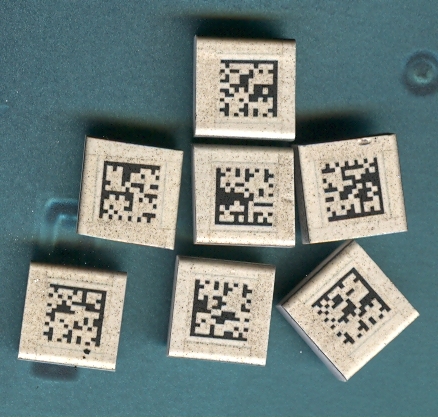
These markings are on a ceramic tile which has been fired to 2150 deg. F
. The codes and tiles can be any size and would be reusable for
tracking parts through through chemical or high temperature processes.
Blank CeramiCodes™ can also be printed on site with piece specific information.

Blank CeramiCodes™ can also be printed on site with piece specific information.
This alumina tag is inserted into
a pocket
which presents the affixed tag below the surface plane. It therefore
cannot be scraped off as the block is scraped during processing.

The alumina tag is designed for long term , high temperature applications. Click the image to see photo after 24 hours at 2000 deg.F

CERAMICODE-WELD

TRANSFER CODES
One method of applying bar codes directly onto ceramics is to preheat the ceramic part ( to approximately 175 Deg C) and then pressure transfer a precut bar code code pattern from a sequential "tape". These codes can survive more than 1200 deg C. See the heating and transfer in a movie which you can download Here
For more information Contact John Robertson @ InfoSight (877) 642 3600
The alumina tag is designed for long term , high temperature applications. Click the image to see photo after 24 hours at 2000 deg.F

CERAMICODE-WELD

Here
, The ceramicode chip is retained in a carbon steel ring using ceramic
adhesive. The ring can then be welded to a steel surface ( eg. a
Mold) and the assembly will survive long term temperatures over 1000
degC. The chip datum lies below the ring top edge to protect the chip
from adjacent mold abrasion.
TRANSFER CODES
One method of applying bar codes directly onto ceramics is to preheat the ceramic part ( to approximately 175 Deg C) and then pressure transfer a precut bar code code pattern from a sequential "tape". These codes can survive more than 1200 deg C. See the heating and transfer in a movie which you can download Here
For more information Contact John Robertson @ InfoSight (877) 642 3600